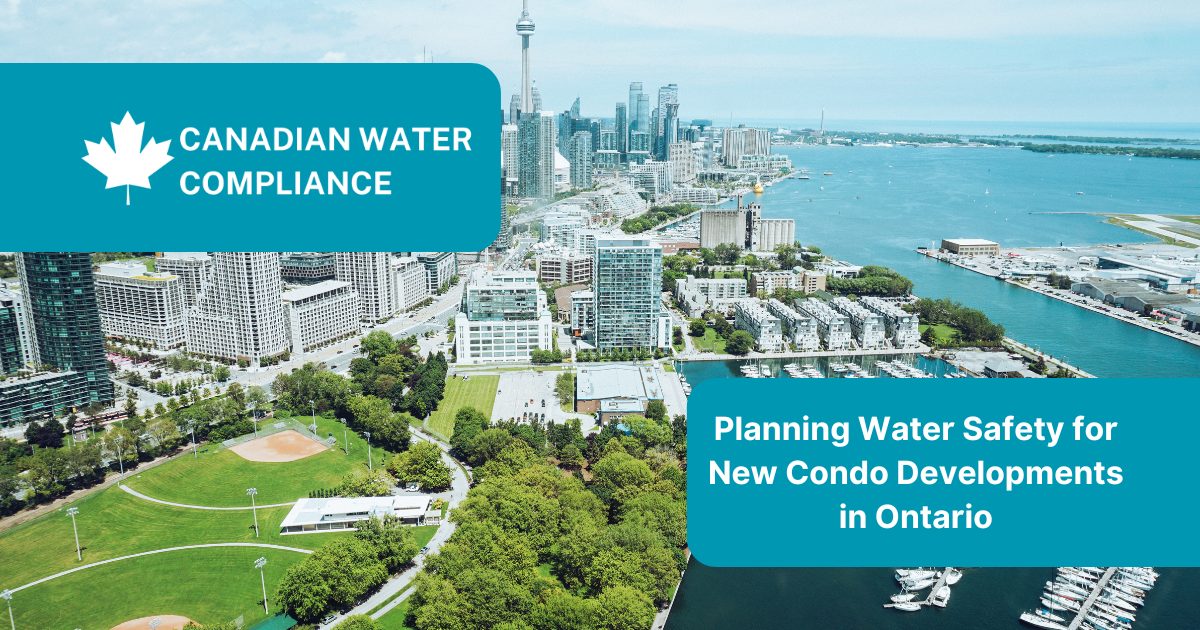
Written By: Canadian Water Compliance | On
When planning a new condominium development in Ontario, water safety is often treated as a backend concern. But smart developers and property managers know that embedding water testing and infrastructure planning into the early stages of construction is critical. Ontario’s Safe Drinking Water Act (SDWA), the Ontario Building Code, and regional municipal requirements make water quality a legal priority from day one.
In this article, we outline how new condo builds can and should plan for water safety from the ground up.
New builds offer a unique opportunity to get water safety right. Unlike older buildings with legacy plumbing systems, new condos can be designed with water testing access points, backflow prevention devices, and water reuse systems that meet current codes. This proactive approach reduces long-term risks like Legionella outbreaks, resident complaints, and costly retrofits.
Planning for water quality also demonstrates good governance. Buyers, tenants, and regulators are increasingly focused on environmental and health safety. Developers who account for this upfront protect not only the future residents but also their own reputational and financial interests.
Ontario developers must comply with several key frameworks:
Safe Drinking Water Act (SDWA): This governs water systems and testing protocols for buildings that supply potable water.
Ontario Building Code (Part 7): Covers plumbing systems, including the installation of backflow prevention devices, water treatment systems, and greywater reuse infrastructure.
Municipal Backflow and Cross-Connection Bylaws: Many Ontario cities (like Toronto and Mississauga) mandate annual backflow testing and certification for new buildings.
In some cases, condo buildings that draw from private water systems may also fall under Ontario Regulation 319/08, which requires ongoing microbiological testing for E. coli and total coliforms.
Here are some foundational best practices developers should incorporate:
Install accessible water sampling ports throughout the building for routine testing.
Implement backflow prevention assemblies at all high-risk cross-connections.
Design for hot water temperature control to reduce Legionella risk.
Include greywater or rainwater reuse systems only if treatment infrastructure is in place and meets the OBC.
Work with certified water testing providers from the start to establish a baseline and long-term sampling plan.
After construction, condo boards and property managers become the stewards of water quality. Developers should leave behind:
A comprehensive water testing plan with sampling locations and frequencies
Records of backflow testing and device certification
Documentation of materials and systems used in the water infrastructure
Contact info for recommended water testing partners
By providing this handoff, developers ensure their project stays compliant and avoids post-handover surprises.
Canadian Water Compliance works with developers, engineers, and building managers across Ontario to integrate water safety into new builds. We offer:
Pre-construction consultation and system audits
Certified water sampling and microbiological testing
Backflow testing and certification
Post-construction water quality programs tailored for condo boards
Whether you're designing a high-rise in downtown Toronto or a mid-rise in a growing suburb, make sure your water system is as modern and secure as the rest of your building.